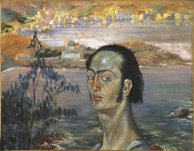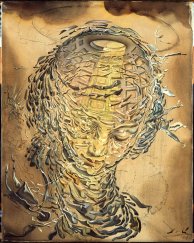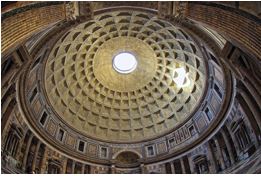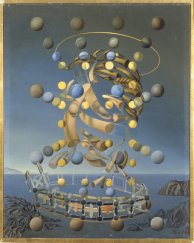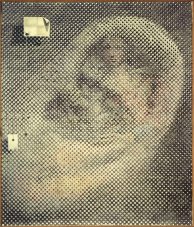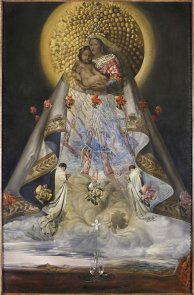Dalí & Raphael in the Catalogue Raisonné
Coordinated by: Nuri Aldeguer, Chief of the Educational Service
Realised by: Andrea Bonet, Anna Garcia, Anna Massot (Art Educators of the Educational Service)
'[...] - and who knows if someday I shall not without intending it be considered the Raphael of my period?'
Salvador Dalí, 50 Secrets of Magic Craftsmanship, 1948
We invite you to immerse yourself in this thrilling Dalinian world by browsing through some of Salvador Dalí's raphaelesque works, in the Catalogue Raisonné of paintings and the essential companion of his writings. Read more
When Dalí was in his second year at the Real Academia de Bellas Artes de San Fernando in Madrid, he felt that the board of examiners were not sufficiently qualified to judge his knowledge and decided to withdraw from the art history examination. The Academy, in turn, chose to expel him. The topic in question was Raphael, the painter Dalí most admired and who he continued to revere for the rest of his life. This attitude coincided with the moment at which the young painter was searching for his own identity, whether through his physical appearance or by shaping his personal style. He had known of and admired Raphael since he was a boy, as Anna Maria Dalí wrote in her book Salvador Dalí as Seen by his Sister: "A colour reproduction of the Madonna of the Chair by Raphael hung above his bed". References to the painter born in Urbino, one of the best known Renaissance artists, would continue to crop up throughout Dalí's career, and in his writings, we find countless examples that reveal how Dalí found much of his inspiration in Raphael.
After the experimental and surrealist period of his youth, Dalí decided to take his work in a different direction with the aim of "becoming a classic". During his stay in the United States in the 1940s, his artistic production began to reflect the powerful influence of his favourite artist. Dalí found a great source of inspiration in Raphael's paintings, particularly the Madonnas which in many cases he copied. This period also coincided with a crucial moment for Dalí, when prompted by the detonation of the atomic bomb in 1945, he developed a powerful interest in physics, particularly the atomic and subatomic world. Above all, it was from 1951 -the year he wrote his Mystical Manifesto- that Raphael's Madonnas would begin to appear in his works, mingled with elements taken from the world of nuclear physics.
While for the Renaissance artists the main aim was to faithfully portray the reality around them using perspective, Dalí wanted to go a step further and, using optical illusions and visual effects, he attempted to create the third and fourth dimensions. During the final years of his career Dalí focused his attention on stereoscopic works and holograms, in which the presence of Raphael still shines through.
-
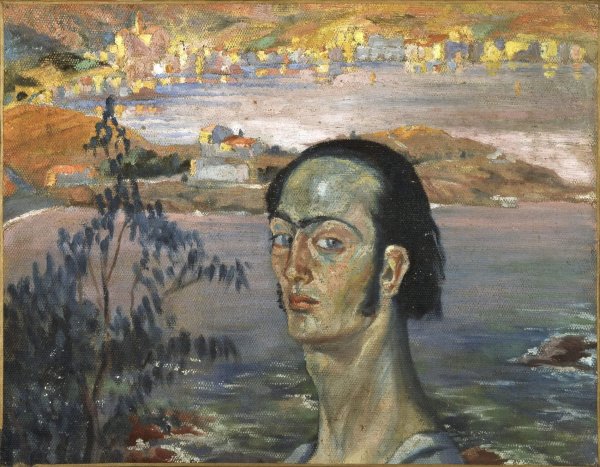
© Salvador Dalí, Fundació Gala-Salvador Dalí, Figueres, 2018 Description
- Cat. no.:
- 103
- Year:
- c. 1921
- Technique:
- Oil on canvas
- Dimensions:
- 40.5 x 53 cm
- Collection:
- Fundació Gala-Salvador Dalí, Figueres
From a very young age, Salvador Dalí had been a great admirer of the Renaissance painter Raphael Sanzio (1483-1520), who he considered an almost divine genius, exalted and venerated in his own time as one of the finest painters of the period. Read more
See no. cat 103When Dalí painted this self-portrait, at the age of just seventeen, he knew Raphael's Self-portrait (1506) very well. He sought to reflect himself in the master by trying to look like him, which is why we see him portrayed with the same profile and elongated neck, referencing the stylised shapes employed in the Renaissance artist's paintings. This homage is also made clear in the title, where he describes his neck as raphaelesque, i.e. in the style of Raphael.
As a teenager Dalí painted many self-portraits -his Self-portrait from 1921, for example- and used this medium to portray the image he wanted to present to the world. Thus, he was expressing his desire for self-affirmation and positioning in the personal and artistic arena. During that period of his life, he painted in the impressionist style, outdoors, with short, broad brushstrokes, and paying particular attention to light and colour.
Throughout his career, Dalí painted the landscape of Cadaqués and Portlligat repeatedly, just as Raphael painted Urbino. Both artists captured in their work an ultra-local scenery which they made universal. Together with landscapes, self-portraits were Dalí's other preferred subject in this period, and in Self-portrait with raphaelesque Neck, painted against the backdrop of Cadaqués, we find the merging of both.
Reference works
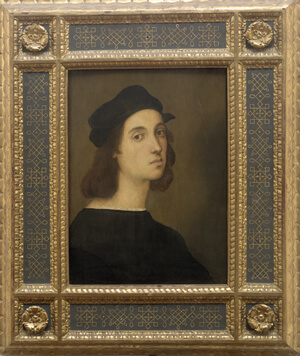
Su concessione del Ministerio dei Beni e le Attività Culturali. La riproduzione, copia totale o parziale, duplicazione della immagine è espressamente vietata
Self-portrait, 1506
Galleria degli Uffizi, FirenzeDalí Dixit
'I had let my hair grow as long as a girl's and looking at myself in the mirror I would often adopt the pose and the melancholy look which so fascinated me in Raphael's self-portrait, and whom I should have liked to resemble as much as possible. I was also waiting impatiently for the down of my face to grow, so that I could shave and have long side-whiskers. As soon as possible I wanted to make myself "look unusual", to compose a masterpiece with my head; [...]'
Salvador Dalí, The Secret Life of Salvador Dalí, 1942
'I need the localism of Portlligat just as Raphael needed the landscape of Urbino, to arrive at the universal by the path of what is particular.'
Salvador Dalí, José María Massip, «Dalí, hoy», Destino, 1/04/1950.
Educa Dalí
The young Dalí sought to give his appearance an unusual character, and to do so he took inspiration from Raphael. Later on he would adopt odd poses and behave strangely to attract attention and make himself visible. As a young man his sideburns gave him this odd appearance, while later his famous moustache would become his trademark.
Look at this literary portrait written by Dalí and then try your hand at creating your own.
A portrait of Salvador Dalí
Most Admired Old Masters: Raphael and Velasquez.
Most Admired Contemporaries: Picasso and I.
My Most Provocative Painting: "Debris of an Automobile Giving Birth to a Blind Horse Biting a Telephone".
Definition of Surrealism : Le surréalisme, c'est moi.
Favorite Color: Absinthe green.
Most Pressing Project: To perfect for the United Nations a system of camouflage based on my radical theory of indivisibility.
Favorite Exercise: Riding up- but not down- in an elevator.
Note to Architects: Your designs are too harsh, too mechanistic - you should cater to man's desire to return to his pre-natal abode by utilizing rounded, non-rigid forms and soft protective materials.
Thought in Passing: Aviation is the most spectacular expression of the sexual instinct.
Proudest Symbol: The sign on my sleeping chamber: "POET WORKING".
Chief Hope for the Future: A religious renaissance based on a progressive form of Catholicism.
Publicat a Esquire , XVIII, n. 2, Nova York, agost del 1942
For further information
- Cristina Jutge, "Portrait of the adolescent artist", El Punt, Girona, 12/09/2005.
- Laura Bartolomé, Io Dalí, Gangemi Editore SpA, p.33-37.
Description
- Cat. no.:
- 103
- Year:
- c. 1921
- Technique:
- Oil on canvas
- Dimensions:
- 40.5 x 53 cm
- Collection:
- Fundació Gala-Salvador Dalí, Figueres
From a very young age, Salvador Dalí had been a great admirer of the Renaissance painter Raphael Sanzio (1483-1520), who he considered an almost divine genius, exalted and venerated in his own time as one of the finest painters of the period. Read more
See no. cat 103When Dalí painted this self-portrait, at the age of just seventeen, he knew Raphael's Self-portrait (1506) very well. He sought to reflect himself in the master by trying to look like him, which is why we see him portrayed with the same profile and elongated neck, referencing the stylised shapes employed in the Renaissance artist's paintings. This homage is also made clear in the title, where he describes his neck as raphaelesque, i.e. in the style of Raphael.
As a teenager Dalí painted many self-portraits -his Self-portrait from 1921, for example- and used this medium to portray the image he wanted to present to the world. Thus, he was expressing his desire for self-affirmation and positioning in the personal and artistic arena. During that period of his life, he painted in the impressionist style, outdoors, with short, broad brushstrokes, and paying particular attention to light and colour.
Throughout his career, Dalí painted the landscape of Cadaqués and Portlligat repeatedly, just as Raphael painted Urbino. Both artists captured in their work an ultra-local scenery which they made universal. Together with landscapes, self-portraits were Dalí's other preferred subject in this period, and in Self-portrait with raphaelesque Neck, painted against the backdrop of Cadaqués, we find the merging of both.
Dalí Dixit
'I had let my hair grow as long as a girl's and looking at myself in the mirror I would often adopt the pose and the melancholy look which so fascinated me in Raphael's self-portrait, and whom I should have liked to resemble as much as possible. I was also waiting impatiently for the down of my face to grow, so that I could shave and have long side-whiskers. As soon as possible I wanted to make myself "look unusual", to compose a masterpiece with my head; [...]'
Salvador Dalí, The Secret Life of Salvador Dalí, 1942
'I need the localism of Portlligat just as Raphael needed the landscape of Urbino, to arrive at the universal by the path of what is particular.'
Salvador Dalí, José María Massip, «Dalí, hoy», Destino, 1/04/1950.
For further information
- Cristina Jutge, "Portrait of the adolescent artist", El Punt, Girona, 12/09/2005.
- Laura Bartolomé, Io Dalí, Gangemi Editore SpA, p.33-37.
-
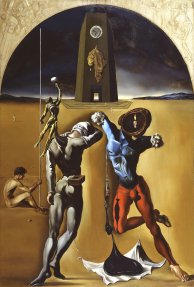
Poetry of America
1943
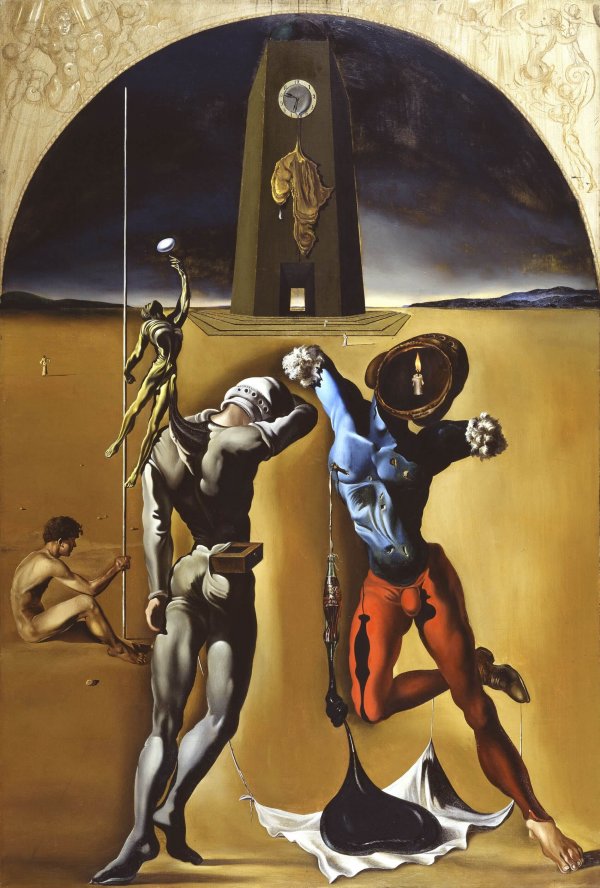
© Salvador Dalí, Fundació Gala-Salvador Dalí, Figueres, 2018 Description
- Cat. no.:
- 577
- Year:
- 1943
- Technique:
- Oil on canvas
- Dimensions:
- 116 x 79 cm
- Collection:
- Fundació Gala-Salvador Dalí, Figueres
In the United States, after his surrealist period in the 1930s and various trips with Gala to Italy, where they were awestruck by the classical architecture and paintings, Salvador Dalí painted Poetry of America. Read more
See no. cat 577This piece, a blend of classicism and innovation, combines a classic Renaissance composition with a hint of the pop art of the future by incorporating the first bottle of Coca-Cola ever seen in the history of art, seventeen years before Andy Warhol (1928-1987, American artist, leading exponent of pop art).
The composition of Poetry of America is reminiscent of Raphael's The Marriage of the Virgin. The paintings share a very similar arrangement: the celestial vault, the tower in the background with its opening, the stairs, the character dressed in red tights and the particular position of his legs. Raphael, in turn, had based his painting on a work of the same name The Marriage of the Virgin (1501-04), by his master Pietro Perugino (1448-1523). So, we can see how Dalí created his own composition using Renaissance characteristics.
Reference works
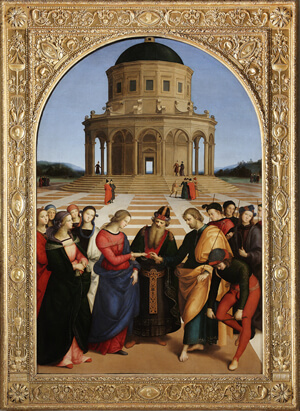
Pinacoteca di Brera, Milano - Ministero per i Beni e le Attività Culturali
The Marriage of the Virgin, 1504
Pinacoteca di Brera, MilanoDalí Dixit
'One perceived then that this armchair was surrounded by the greatest artistic treasures in the world. Raphael's Betrothal of the Virgin, from the Museum of Milan, Leonardo's Virgin of the Rocks... Piles of the rarest and most priceless manuscripts, and over there, behind him, in the half-light in the center of the room, the Victory of Samothrace- the real one, the one from the Louvre museum, but looking in this horrible rigid room like a bad reproduction.'
Salvador Dalí, Hidden Faces, 1944
"Gala became the impregnable castle that she had never ceased to be. Intimacy and, above all, familiarity, diminish all passions. Sentimental rigour and distance, as demonstrated by the neurotic ceremony of courtly love, make passion grow. Thus, I remember that, after a long silence before Raphael's The Marriage of the Virgin, in the museum of Milan, Gala sighed and said: 'What an honour never to have known any member of Raphael's family. Imagine what a catastrophe it would be to be introduced to Raphael's aunt, albeit a distant one'".
Salvador Dalí, Le point de vue de Dalí, Vogue, n. 522, Paris, 12/1971 – 01/1972
Educa Dalí
Even though Dalí looked up to the Renaissance masters, in Poetry of America we can see how ahead of his time he was by incorporating a bottle of Coca-Cola into his painting.
Try being like Dalí and add some new elements in a collage on one of your works. You will obtain totally new and original compositions. Try the same experiment on one of Raphael's works and compare them.
For further information
- Fèlix Fanés. DALÍ. Cultura de Masses. Fundació La Caixa: Barcelona; Fundació Gala-Salvador Dalí: Figueres; Museo Nacional Centro de Arte Reina Sofía: Madrid, 2004, p. 43.
Description
- Cat. no.:
- 577
- Year:
- 1943
- Technique:
- Oil on canvas
- Dimensions:
- 116 x 79 cm
- Collection:
- Fundació Gala-Salvador Dalí, Figueres
In the United States, after his surrealist period in the 1930s and various trips with Gala to Italy, where they were awestruck by the classical architecture and paintings, Salvador Dalí painted Poetry of America. Read more
See no. cat 577This piece, a blend of classicism and innovation, combines a classic Renaissance composition with a hint of the pop art of the future by incorporating the first bottle of Coca-Cola ever seen in the history of art, seventeen years before Andy Warhol (1928-1987, American artist, leading exponent of pop art).
The composition of Poetry of America is reminiscent of Raphael's The Marriage of the Virgin. The paintings share a very similar arrangement: the celestial vault, the tower in the background with its opening, the stairs, the character dressed in red tights and the particular position of his legs. Raphael, in turn, had based his painting on a work of the same name The Marriage of the Virgin (1501-04), by his master Pietro Perugino (1448-1523). So, we can see how Dalí created his own composition using Renaissance characteristics.
Dalí Dixit
'One perceived then that this armchair was surrounded by the greatest artistic treasures in the world. Raphael's Betrothal of the Virgin, from the Museum of Milan, Leonardo's Virgin of the Rocks... Piles of the rarest and most priceless manuscripts, and over there, behind him, in the half-light in the center of the room, the Victory of Samothrace- the real one, the one from the Louvre museum, but looking in this horrible rigid room like a bad reproduction.'
Salvador Dalí, Hidden Faces, 1944
"Gala became the impregnable castle that she had never ceased to be. Intimacy and, above all, familiarity, diminish all passions. Sentimental rigour and distance, as demonstrated by the neurotic ceremony of courtly love, make passion grow. Thus, I remember that, after a long silence before Raphael's The Marriage of the Virgin, in the museum of Milan, Gala sighed and said: 'What an honour never to have known any member of Raphael's family. Imagine what a catastrophe it would be to be introduced to Raphael's aunt, albeit a distant one'".
Salvador Dalí, Le point de vue de Dalí, Vogue, n. 522, Paris, 12/1971 – 01/1972
For further information
- Fèlix Fanés. DALÍ. Cultura de Masses. Fundació La Caixa: Barcelona; Fundació Gala-Salvador Dalí: Figueres; Museo Nacional Centro de Arte Reina Sofía: Madrid, 2004, p. 43.
-
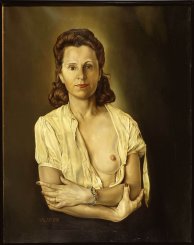
Galarina
1945
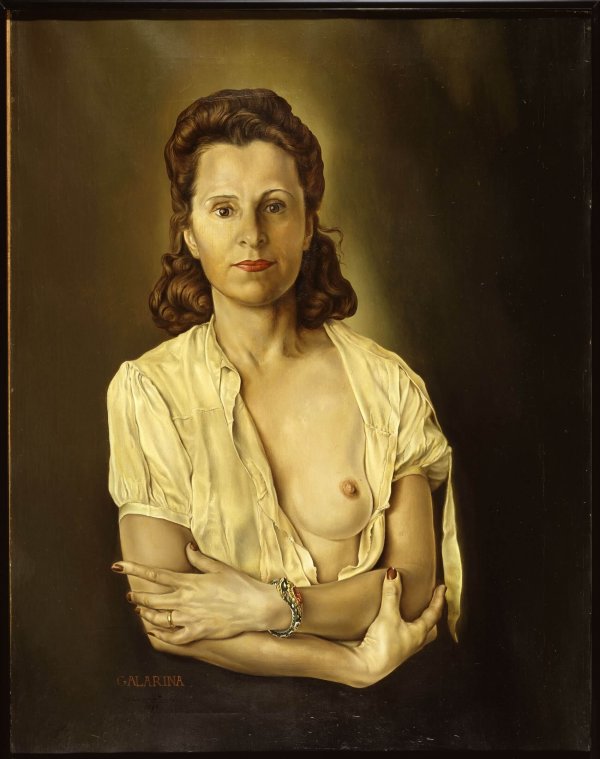
© Salvador Dalí, Fundació Gala-Salvador Dalí, Figueres, 2018 Description
- Cat. no.:
- 597
- Year:
- 1945
- Technique:
- Oil on Canvas
- Dimensions:
- 64 x 50 cm
- Collection:
- Fundació Gala-Salvador Dalí, Figueres
Dalí and Gala lived in the United States for eight years, between New York and California. They arrived in 1940, fleeing from the Second World War. In 1941, Dalí exhibited at the Julien Levy Gallery in New York. Read more
See no. cat 597The text of the exhibition catalogue was quite a declaration of intent: "To become a classic! Now or never". Dalí demonstrates his mastery of classical techniques in this portrait of Gala. Once again, it is based on Raphael's works following his stylistic lead.
In Galarina, moreover, he uses the title to pay homage to his favourite painter by adapting Gala's name to Galarina so that it would resemble the name of Raphael's muse, Fornarina. Dalí exhibited the painting Galarina at the Bignou Gallery in New York in 1945, declaring that he had painted this oil over six months, working three hours a day, and that he had named it Galarina because Gala was to him what the Fornarina was to Raphael: a great inspiration
Reference works
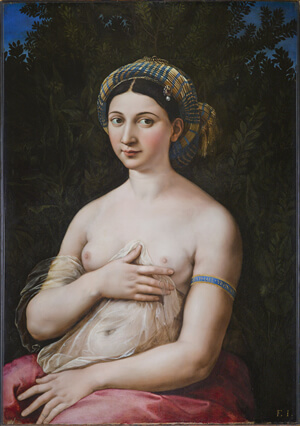
Per gentile concessione di Gallerie Nazionale di Arte Antica. Foto di Mauro Coen.
La Fornarina, c. 1520
Gallerie Nazionali - Palazzo Barberini, RomaEduca Dalí
During the Renaissance period, artists were mainly commissioned to produce specific works. However, this is not the case of La Fornarina, which Raphael created for himself during the final years of his life.
The model in this painting is posed like a Venus pudica, one of the most commonly used artistic motifs during classical antiquity, in which Venus attempts to cover her breasts and pubis, a gesture that actually draws the viewer to focus, precisely, on what the model is trying to hide. We can see the Fornarina trying to lightly cover one breast, while Gala, in contrast, reveals one and hides the other beneath her blouse. Both women are wearing a bracelet, a symbol of union and a love bond, in the shape of a serpent in Gala's case and, in the Fornarina's, engraved with the name of the painter, Raphael Urbinas. Dalí linkened Gala's bare breast to the hunk of bread in his work The Basket of Bread from the same year.
For further information
- Lucia Moni. Dalí, to become a classic! Now or never. November 2018
Description
- Cat. no.:
- 597
- Year:
- 1945
- Technique:
- Oil on Canvas
- Dimensions:
- 64 x 50 cm
- Collection:
- Fundació Gala-Salvador Dalí, Figueres
Dalí and Gala lived in the United States for eight years, between New York and California. They arrived in 1940, fleeing from the Second World War. In 1941, Dalí exhibited at the Julien Levy Gallery in New York. Read more
See no. cat 597The text of the exhibition catalogue was quite a declaration of intent: "To become a classic! Now or never". Dalí demonstrates his mastery of classical techniques in this portrait of Gala. Once again, it is based on Raphael's works following his stylistic lead.
In Galarina, moreover, he uses the title to pay homage to his favourite painter by adapting Gala's name to Galarina so that it would resemble the name of Raphael's muse, Fornarina. Dalí exhibited the painting Galarina at the Bignou Gallery in New York in 1945, declaring that he had painted this oil over six months, working three hours a day, and that he had named it Galarina because Gala was to him what the Fornarina was to Raphael: a great inspiration
For further information
- Lucia Moni. Dalí, to become a classic! Now or never. November 2018
-
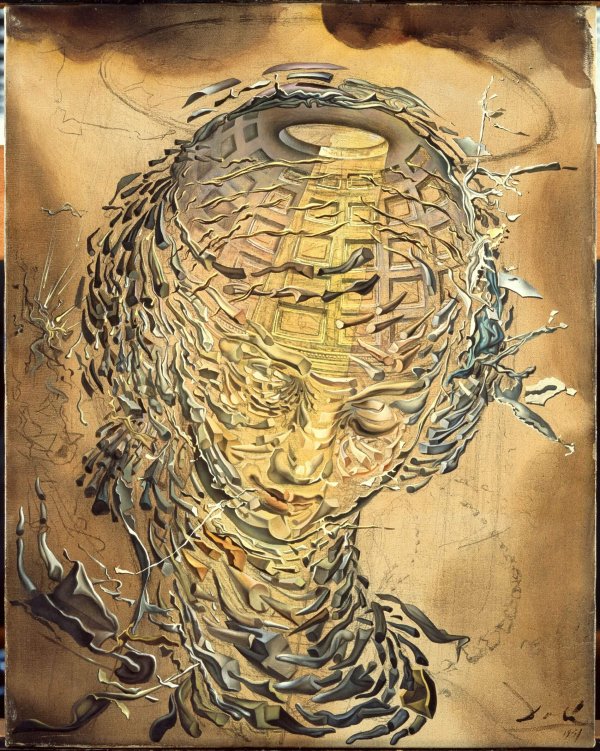
© Salvador Dalí, Fundació Gala-Salvador Dalí, Figueres, 2018 Description
- Cat. no.:
- 661
- Year:
- 1951
- Technique:
- Oil on canvas
- Dimensions:
- 43.2 x 33.1 cm
- Collection:
- Scottish National Gallery, Edimburg
From a very young age, Dalí showed a great interest in the world of science, and his library contained many books on physics, quantum mechanics and mathematics. Read more
See no. cat 661In this last field, he particularly admired some books on architecture, including a treatise by Luca Pacioli (1445-1514), whose knowledge encompassed many fields.
Along these same lines we find Dalí, who, thanks to his interest in and study of so many different disciplines, could also be considered a Renaissance man. One of Luca Pacioli's best remembered treatises is The Divine Proportion, which Dalí studied exhaustively during the late 1940s. The book was written in collaboration with Leonardo da Vinci (1452-1519, artist, engineer, inventor, anatomist...), with whom Pacioli studied the golden ratio in depth. We should also remember Da Vinci's studies of the proportions of the human body in his famous illustration of the Vitruvian Man, in which he refers to the treatise De architectura by Vitruvius (1st century BCE), one of the most important works from ancient Rome. Dalí also referenced this text in a sketch for the work Leda Atomica, on demostra tots els coneixements que va adquirir a través d'aquests tractats.
In this painting we find a series of elements expressed at speed and disintegrating which, seen as a whole, reveal the face of a Raphaelesque Madonna that is initially camouflaged in the rest of the composition. At the same time, we can see that the head of this Madonna is also the dome of the Pantheon in Rome, a Roman temple that is considered to be a milestone in architectural perfection and is also where Raphael is entombed.
Reference works
Dome of the Pantheon of Agrippa. Photo Wikiarquitectura.cat
Pantheon, Rome
Dalí Dixit
“S.R. Do you think that the painters you admire like Vermeer and Raphael were learned in the scientific knowledge of their times?
S.D. Raphael knew about every scientific mathematical achievement of his time. Don't forget that it was the period of Luca Pacioli”
Selden Rodman, Salvador Dalí, “Dalí The Great?”, Controversy, Philadelphia, 31/05/1959
"The Renaissance cupolas that corresponded to the cupola of heaven in a flash of genius appear to me as the receptacles of conscience. I go back to that theme in Tête raphaelesque explosant (Raphaelesque Head Exploding) and express a transcendent metaphysical message in my Mystic Manifesto.'
André Parinaud, Salvador Dalí Comment on devient Dalí, 1973.
Educa Dalí
The Renaissance, as the name indicates, was a period of rebirth of a society that was slowly abandoning Medieval ways of thinking -based much more on theocentric concepts- to begin to view knowledge from an anthropocentric perspective. Human beings became the centre of the universe, rather than God: humanist thought appeared and the modern age was born.
In the field of art, painting progressed to represent reality in a much more plausible manner; for this reason, techniques of perspective gained greater relevance. It was an important moment for treatises on painting and architecture, which Dalí read eagerly. One of the most renowned texts from this period is The Lives of the Most Excellent Painters, Sculptors, and Architects, by Giorgio Vasari, published in 1550, which contains the biographies of figures such as Raphael, who Vasari called "the divine".
For further information
- Carme Ruiz, "Salvador Dalí and science. Beyond a mere curiosity". Centre for Dalinian Studies, Fundació Gala-Salvador Dalí: Figueres, 2010.
Description
- Cat. no.:
- 661
- Year:
- 1951
- Technique:
- Oil on canvas
- Dimensions:
- 43.2 x 33.1 cm
- Collection:
- Scottish National Gallery, Edimburg
From a very young age, Dalí showed a great interest in the world of science, and his library contained many books on physics, quantum mechanics and mathematics. Read more
See no. cat 661In this last field, he particularly admired some books on architecture, including a treatise by Luca Pacioli (1445-1514), whose knowledge encompassed many fields.
Along these same lines we find Dalí, who, thanks to his interest in and study of so many different disciplines, could also be considered a Renaissance man. One of Luca Pacioli's best remembered treatises is The Divine Proportion, which Dalí studied exhaustively during the late 1940s. The book was written in collaboration with Leonardo da Vinci (1452-1519, artist, engineer, inventor, anatomist...), with whom Pacioli studied the golden ratio in depth. We should also remember Da Vinci's studies of the proportions of the human body in his famous illustration of the Vitruvian Man, in which he refers to the treatise De architectura by Vitruvius (1st century BCE), one of the most important works from ancient Rome. Dalí also referenced this text in a sketch for the work Leda Atomica, on demostra tots els coneixements que va adquirir a través d'aquests tractats.
In this painting we find a series of elements expressed at speed and disintegrating which, seen as a whole, reveal the face of a Raphaelesque Madonna that is initially camouflaged in the rest of the composition. At the same time, we can see that the head of this Madonna is also the dome of the Pantheon in Rome, a Roman temple that is considered to be a milestone in architectural perfection and is also where Raphael is entombed.
Dalí Dixit
“S.R. Do you think that the painters you admire like Vermeer and Raphael were learned in the scientific knowledge of their times?
S.D. Raphael knew about every scientific mathematical achievement of his time. Don't forget that it was the period of Luca Pacioli”
Selden Rodman, Salvador Dalí, “Dalí The Great?”, Controversy, Philadelphia, 31/05/1959
"The Renaissance cupolas that corresponded to the cupola of heaven in a flash of genius appear to me as the receptacles of conscience. I go back to that theme in Tête raphaelesque explosant (Raphaelesque Head Exploding) and express a transcendent metaphysical message in my Mystic Manifesto.'
André Parinaud, Salvador Dalí Comment on devient Dalí, 1973.
For further information
- Carme Ruiz, "Salvador Dalí and science. Beyond a mere curiosity". Centre for Dalinian Studies, Fundació Gala-Salvador Dalí: Figueres, 2010.
-
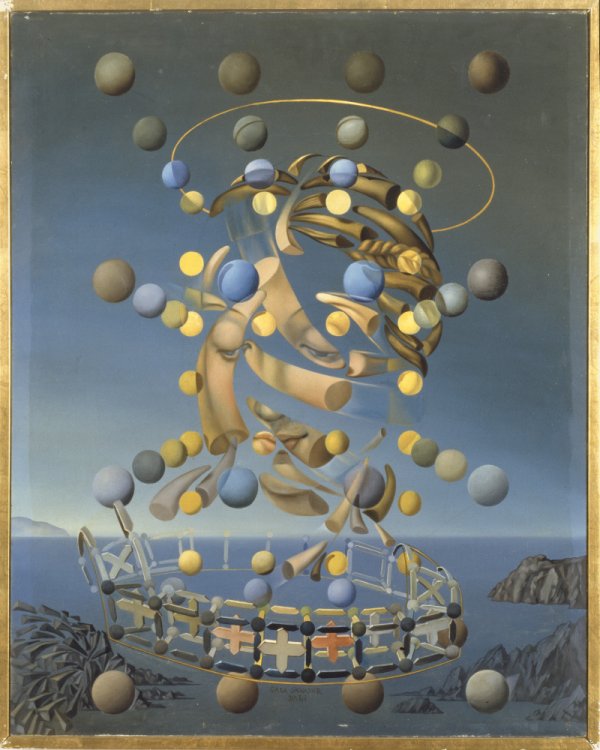
© Salvador Dalí, Fundació Gala-Salvador Dalí, Figueres, 2018 Description
- Cat. no.:
- 683
- Year:
- c. 1954
- Technique:
- Oil on Canvas
- Dimensions:
- 81 x 66 cm
- Collection:
- Museo Nacional Centro de Arte Reina Sofía, Madrid
To feed his passionate interest in science that we have mentioned, Dalí took out subscriptions to different scientific journals which kept him up-to-date with all the various studies that were conducted in his day. Read more
See no. cat 683The surrealist movement also expressed deep curiosity about modern physics, above all, after the publication of Albert Einstein's Theory of Relativity (1879-1955, German/US physicist and one of the most important scientists of the 20th century).
In 1945, the detonation of the atomic bomb "sent a seismic shock" through Dalí and led him to dedicate great efforts to the study and knowledge of atoms. The painter found a channel for understanding the core of reality in mysticism, and in 1951 he wrote his Mystical Manifesto. Dalí called the fusion of mysticism and science nuclear mysticism.
This composition may bring to mind the famous work by Salvador Dalí Galatea of the Spheres, which shows a series of circular particles that, apparently in motion, remind us of a basic tenet of quantum mechanics: Werner Karl Heisenberg's (1901-1976, German physicist, recognised for his work in quantum mechanics) Uncertainty Principle. If we look closer at the face in this painting we realise that it has the same features as the previously mentioned Galatea of the Spheres, but instead of Gala's face we find the face of Raphael's Madonna of the Goldfinch. Once again, Dalí combines themes referring to nuclear mysticism: the classical aesthetic and the world of science.
Reference works
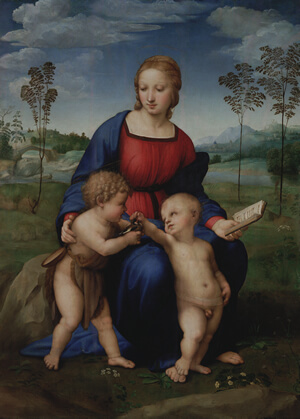
Su concessione del Ministerio dei Beni e le Attività Culturali. La riproduzione, copia totale o parziale, duplicazione della immagine è espressamente vietata.
Madonna of the Goldfinch, 1507
Galleria degli Uffizi, FirenzeDalí Dixit
“The atomic explosion of August 6, 1945 shook me seismically. Thenceforth, the atom was my favorite food for thought. Many of the landscapes painted in this period express the great fear inspired in me by the announcement of that explosion.”
André Parinaud, Salvador Dalí Comment on devient Dalí, 1973.
“Galatea the Galanymph of pure and gigantic marine geology, is slowly but ineluctably taking shape in the Raphaelite-nuclear impulse of my next and brilliant painting.”
Salvador Dalí Journal d’un génie. La Table Ronde, Paris, 1964.
Educa Dalí
Atomic theories surprised and inspired Dalí to the extent that he turned his work around completely, with his style becoming known thereafter as Nuclear Mysticism. The mysticism of the classics combined with nuclear theories became Dalí's source of stylistic inspiration. The theoretical corpus from this period culminates with the publication of his Mystical Manifesto. Dalí declared that there was an unexpected poetry in the integration and disintegration of the atom, to the extent that he began to atomise and disintegrate his compositions, as we can see in the work Maximum Speed of Raphael's Madonna.
Try disintegrating a work that you like into spherical atoms. You will almost certainly find the unexpected poetry Dalí talked about.
For further information
Description
- Cat. no.:
- 683
- Year:
- c. 1954
- Technique:
- Oil on Canvas
- Dimensions:
- 81 x 66 cm
- Collection:
- Museo Nacional Centro de Arte Reina Sofía, Madrid
To feed his passionate interest in science that we have mentioned, Dalí took out subscriptions to different scientific journals which kept him up-to-date with all the various studies that were conducted in his day. Read more
See no. cat 683The surrealist movement also expressed deep curiosity about modern physics, above all, after the publication of Albert Einstein's Theory of Relativity (1879-1955, German/US physicist and one of the most important scientists of the 20th century).
In 1945, the detonation of the atomic bomb "sent a seismic shock" through Dalí and led him to dedicate great efforts to the study and knowledge of atoms. The painter found a channel for understanding the core of reality in mysticism, and in 1951 he wrote his Mystical Manifesto. Dalí called the fusion of mysticism and science nuclear mysticism.
This composition may bring to mind the famous work by Salvador Dalí Galatea of the Spheres, which shows a series of circular particles that, apparently in motion, remind us of a basic tenet of quantum mechanics: Werner Karl Heisenberg's (1901-1976, German physicist, recognised for his work in quantum mechanics) Uncertainty Principle. If we look closer at the face in this painting we realise that it has the same features as the previously mentioned Galatea of the Spheres, but instead of Gala's face we find the face of Raphael's Madonna of the Goldfinch. Once again, Dalí combines themes referring to nuclear mysticism: the classical aesthetic and the world of science.
Dalí Dixit
“The atomic explosion of August 6, 1945 shook me seismically. Thenceforth, the atom was my favorite food for thought. Many of the landscapes painted in this period express the great fear inspired in me by the announcement of that explosion.”
André Parinaud, Salvador Dalí Comment on devient Dalí, 1973.
“Galatea the Galanymph of pure and gigantic marine geology, is slowly but ineluctably taking shape in the Raphaelite-nuclear impulse of my next and brilliant painting.”
Salvador Dalí Journal d’un génie. La Table Ronde, Paris, 1964.
-
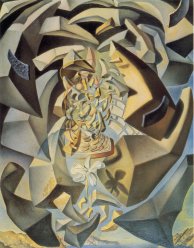
Microphysical Madonna
c. 1954
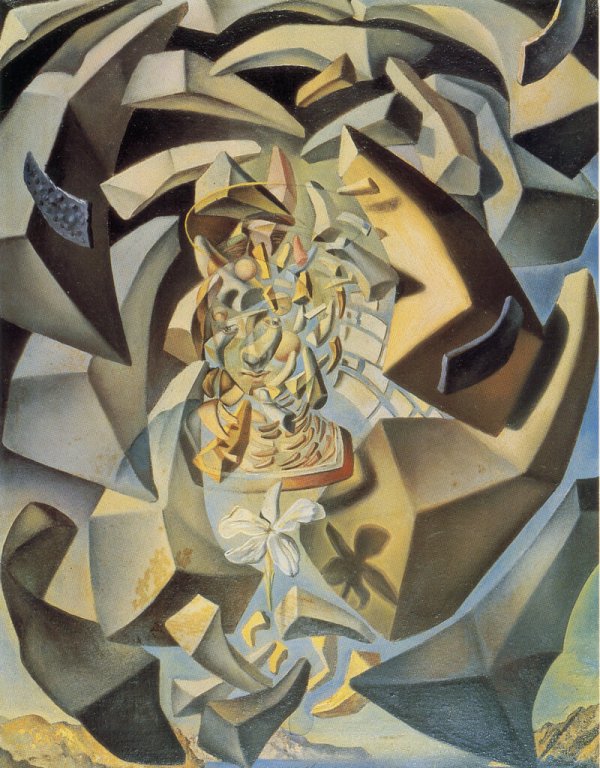
© Salvador Dalí, Fundació Gala-Salvador Dalí, Figueres, 2018 Description
- Cat. no.:
- 685
- Year:
- c. 1954
- Technique:
- Oil on Canvas
- Dimensions:
- 24.5 x 18.7 cm
- Collection:
- Private collection
We have already talked about Dalí's keen interest in some treatises on architecture, particularly the one written by Luca Pacioli, in which he explains the golden ratio, also known as the divine proportion. Read more
See no. cat 685Dalí took every opportunity to draw elements in nature that demonstrated this perfect proportion, and the rhinoceros horn is one of them. Its curve has a perfect logarithmic shape; that is why this part of the rhinoceros appears time and again in Dalinian works from the 1950s onwards, when the painter decided to infuse his paintings with mathematical knowledge together with a classical language rich in references to Raphael.
In this work, the face of the Madonna of the Goldfinch by Raphael appears between a group of rhinoceros horns that express speed and disintegration.
Reference works
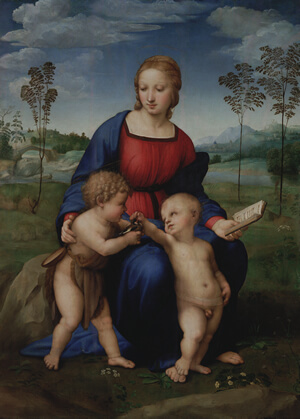
Su concessione del Ministerio dei Beni e le Attività Culturali. La riproduzione, copia totale o parziale, duplicazione della immagine è espressamente vietata.
Madonna of the goldfinch, 1507
Galleria degli Uffizi, FirenzeDalí Dixit
"The rhinoceros is the only animal that has a perfect logarithmic curve on the end of its nose. That interests me. Leonardo da Vinci studied the sunflower, and I have studied the cauliflower; one day I went to give a lecture at the Sorbonne in a Rolls Royce filled with cauliflowers. It was totally outrageous".
Michaël DelMar, Salvador Dalí, “Astroview”, Façade, Paris, 1978
Educa Dalí
The Fibonacci spiral is the perfect logarithmic shape found in the golden ratio. You can see this feature in the shape of sunflower seeds, cauliflowers, the shells of marine animals, artichoke flowers, rhinoceros horns, sea urchins, etc. If you look closely, the repeated incorporation of all these elements in Dalí's work is no coincidence.
Look for the perfect spiral in the natural elements around you: you will be surprised to find them everywhere.
For further information
Description
- Cat. no.:
- 685
- Year:
- c. 1954
- Technique:
- Oil on Canvas
- Dimensions:
- 24.5 x 18.7 cm
- Collection:
- Private collection
We have already talked about Dalí's keen interest in some treatises on architecture, particularly the one written by Luca Pacioli, in which he explains the golden ratio, also known as the divine proportion. Read more
See no. cat 685Dalí took every opportunity to draw elements in nature that demonstrated this perfect proportion, and the rhinoceros horn is one of them. Its curve has a perfect logarithmic shape; that is why this part of the rhinoceros appears time and again in Dalinian works from the 1950s onwards, when the painter decided to infuse his paintings with mathematical knowledge together with a classical language rich in references to Raphael.
In this work, the face of the Madonna of the Goldfinch by Raphael appears between a group of rhinoceros horns that express speed and disintegration.
Dalí Dixit
"The rhinoceros is the only animal that has a perfect logarithmic curve on the end of its nose. That interests me. Leonardo da Vinci studied the sunflower, and I have studied the cauliflower; one day I went to give a lecture at the Sorbonne in a Rolls Royce filled with cauliflowers. It was totally outrageous".
Michaël DelMar, Salvador Dalí, “Astroview”, Façade, Paris, 1978
-
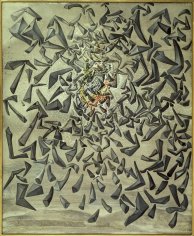
The Ascension of Saint Cecilia
c. 1955
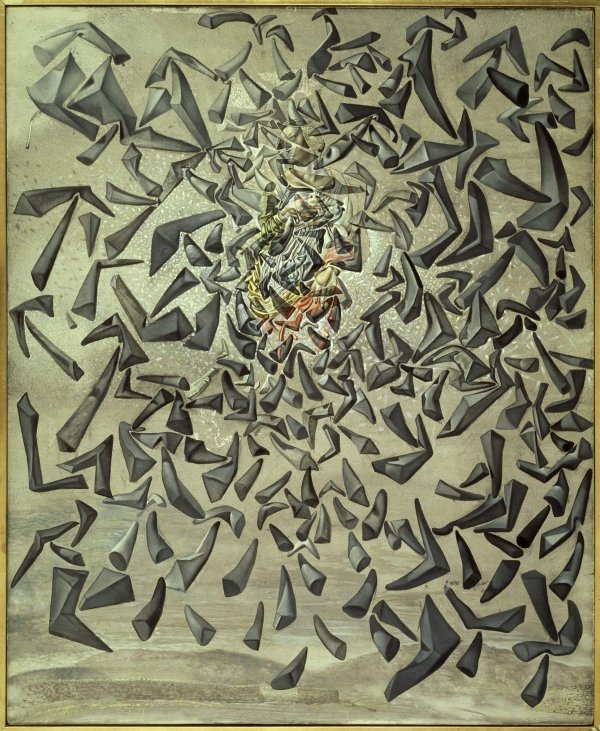
© Salvador Dalí, Fundació Gala-Salvador Dalí, Figueres, 2018 Description
- Cat. no.:
- 706
- Year:
- c. 1955
- Technique:
- Oil on canvas
- Dimensions:
- 81.5 x 66.5 cm
- Collection:
- Fundació Gala-Salvador Dalí, Figueres
In this painting Salvador Dalí tackles the great religious theme of ascension. At first glance you might be forgiven for thinking that the canvas is covered exclusively in rhinoceros horns, but if you look carefully at the centre of the composition you will see the figure of a woman hiding there, and not just any woman, but Raphael's Saint Catherine of Alexandria, from 1507. Read more
See no. cat 706Once again, we can clearly see the Renaissance artist's influence on Dalí, who created this work in his studio in Portlligat with a reproduction of the painting by Raphael placed nearby on an easel as a guide. Photographs of Dalí working in his studios and an observation of his artist's materials provide us with very valuable information about his working methods. Dalí traced the reproduction using the grid method -consisting of drawing a grid over the image you want to copy, a technique that helps to enlarge or reduce the size of the example- and transferred this sketch to the canvas through the transparent sheet.
So, on the one hand we have established that Dalí had completely mastered his technical resources -he was highly skilled in the techniques of copying, tracing and transferring images- but, in addition, he knew how to integrate these images into his own unique world; in this case, nuclear mysticism. The result is a work of extraordinary creativity.
Reference works
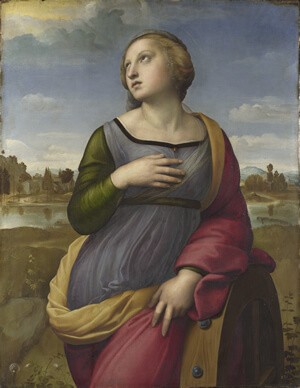
© The National Gallery, London
Saint Catherine of Alexandria, c. 1507
The National Gallery, LondonDalí Dixit
"I have discovered that in Raphael one can see very noticeably in the neck, in the shape of the neck, I have analysed it, that everything is formed, just like these angles, from cubes and cylinders; Raphael painted only with profiles, shapes closely resembling the logarithmic curves that are found in a rhinoceros horn".
Salvador Dalí, “Aspects phénoménologiques de la méthode paranoïaque critique. Conférence en Sorbonne”, La Vie Médicale, Paris, Décembre 1956.
'What is important is that we must paint the subjects in a way that corresponds to the time we live in, 1951; this means that if Raphael painted a virgin according to the cosmogony of the Renaissance, today this cosmogony has varied. The same subject that Raphael painted, if Raphael painted it today, because he would have other knowledge (nuclear physics, psychoanalysis, for example), he would paint as well as then, but he would respond to today's cosmogony. And the religious theme is, for me, the oldest and the most current; but it must be treated according to the scientific knowledge of our time [...].'
Manuel del Arco, Salvador Dalí, Dalí al desnudo, 1952.
"It is untrue that I hold myself to be the greatest painter in the world, as people have said. Painting, for me, is only one of the most imperfect manifestations of my intelligence. I am a terrible painter. If I compare my canvases with those of the Renaissance, with Raphael's works, for example, I am aware that all of my work is a total disaster. But this does not prevent me from being, thanks to my style, one of today's greatest artists".
S.a., Salvador Dalí, Une interview exceptionnelle Dalí se confesse, Arts, n. 674, Paris, 11/06/1958
Educa Dalí
We can see how, in the process of creating the painting The Ascension of Saint Cecilia, Dalí used a traced copy of the work by Raphael. Dalí had absolutely no qualms about copying the classics; in fact, he admired them enormously and, in comparison with them, considered himself a very modest painter.
For further information
- Montse Aguer, Outstanding Work: The Ascension of Saint Cecilia. November 2018
- Irene Civil, In Dalí's Studio. On the working method in The Ascension of Saint Cecilia. November 2018
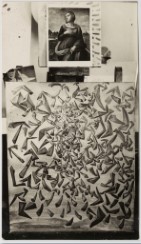
Publifoto: Dalí's oil painting The Ascension of Saint Cecilia with a reproduction of Raphael's Saint Catherine of Alexandria in his studio at Portlligat, ca. 1955. Fundació Gala-Salvador Dalí, Figueres.
PublifotoDescription
- Cat. no.:
- 706
- Year:
- c. 1955
- Technique:
- Oil on canvas
- Dimensions:
- 81.5 x 66.5 cm
- Collection:
- Fundació Gala-Salvador Dalí, Figueres
In this painting Salvador Dalí tackles the great religious theme of ascension. At first glance you might be forgiven for thinking that the canvas is covered exclusively in rhinoceros horns, but if you look carefully at the centre of the composition you will see the figure of a woman hiding there, and not just any woman, but Raphael's Saint Catherine of Alexandria, from 1507. Read more
See no. cat 706Once again, we can clearly see the Renaissance artist's influence on Dalí, who created this work in his studio in Portlligat with a reproduction of the painting by Raphael placed nearby on an easel as a guide. Photographs of Dalí working in his studios and an observation of his artist's materials provide us with very valuable information about his working methods. Dalí traced the reproduction using the grid method -consisting of drawing a grid over the image you want to copy, a technique that helps to enlarge or reduce the size of the example- and transferred this sketch to the canvas through the transparent sheet.
So, on the one hand we have established that Dalí had completely mastered his technical resources -he was highly skilled in the techniques of copying, tracing and transferring images- but, in addition, he knew how to integrate these images into his own unique world; in this case, nuclear mysticism. The result is a work of extraordinary creativity.
Dalí Dixit
"I have discovered that in Raphael one can see very noticeably in the neck, in the shape of the neck, I have analysed it, that everything is formed, just like these angles, from cubes and cylinders; Raphael painted only with profiles, shapes closely resembling the logarithmic curves that are found in a rhinoceros horn".
Salvador Dalí, “Aspects phénoménologiques de la méthode paranoïaque critique. Conférence en Sorbonne”, La Vie Médicale, Paris, Décembre 1956.
'What is important is that we must paint the subjects in a way that corresponds to the time we live in, 1951; this means that if Raphael painted a virgin according to the cosmogony of the Renaissance, today this cosmogony has varied. The same subject that Raphael painted, if Raphael painted it today, because he would have other knowledge (nuclear physics, psychoanalysis, for example), he would paint as well as then, but he would respond to today's cosmogony. And the religious theme is, for me, the oldest and the most current; but it must be treated according to the scientific knowledge of our time [...].'
Manuel del Arco, Salvador Dalí, Dalí al desnudo, 1952.
"It is untrue that I hold myself to be the greatest painter in the world, as people have said. Painting, for me, is only one of the most imperfect manifestations of my intelligence. I am a terrible painter. If I compare my canvases with those of the Renaissance, with Raphael's works, for example, I am aware that all of my work is a total disaster. But this does not prevent me from being, thanks to my style, one of today's greatest artists".
S.a., Salvador Dalí, Une interview exceptionnelle Dalí se confesse, Arts, n. 674, Paris, 11/06/1958
For further information
- Montse Aguer, Outstanding Work: The Ascension of Saint Cecilia. November 2018
- Irene Civil, In Dalí's Studio. On the working method in The Ascension of Saint Cecilia. November 2018

Publifoto: Dalí's oil painting The Ascension of Saint Cecilia with a reproduction of Raphael's Saint Catherine of Alexandria in his studio at Portlligat, ca. 1955. Fundació Gala-Salvador Dalí, Figueres.
Publifoto -
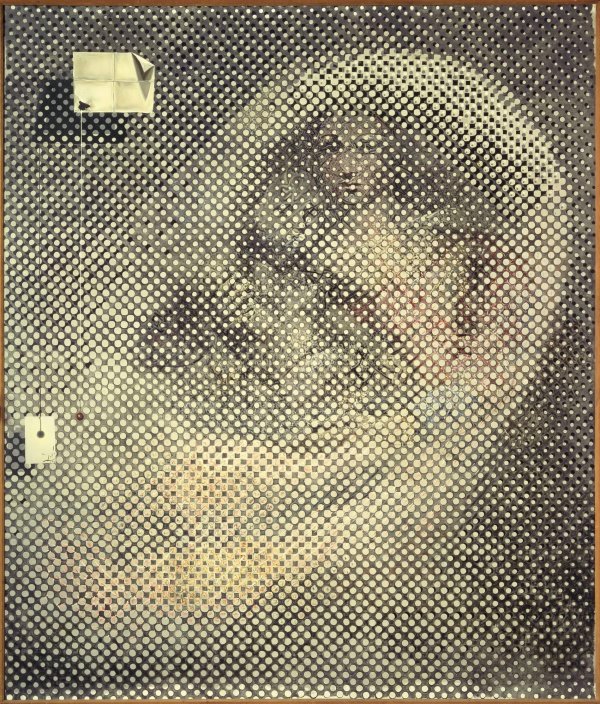
© Salvador Dalí, Fundació Gala-Salvador Dalí, Figueres, 2018 Photo © 1987 The Metropolitan Museum of Art Description
- Cat. no.:
- 734
- Year:
- 1958
- Technique:
- Oil on canvas
- Dimensions:
- 225.7 x 191.1 cm
- Collection:
- The Metropolitan Museum of Art, Nova York
In 1958, Dalí wrote The Antimatter Manifesto, in which he states that his iconographic world no longer explores the internal realm of the surrealist period with constant references to Sigmund Freud (1856-1939, neurologist, father of psychoanalysis), but instead focuses on exploring the external world, the world of physics. Dalí declared that the new father of this science was Doctor Heisenberg, the physicist who developed the uncertainty principle, according to which it is impossible to know both the velocity and the position of a particle at the same time. Read more
See no. cat 734In 1958, Dalí wrote The Antimatter Manifesto, in which he states that his iconographic world no longer explores the internal realm of the surrealist period with constant references to Sigmund Freud (1856-1939, neurologist, father of psychoanalysis), but instead focuses on exploring the external world, the world of physics. Dalí declared that the new father of this science was Doctor Heisenberg, the physicist who developed the uncertainty principle, according to which it is impossible to know both the velocity and the position of a particle at the same time.
In this painting, as Dalí explains in the subtitle, he presents us with a visual game in which three different images appear depending on how far away we stand from the picture. Dalí loved visual games and optical illusions. As an example, we draw your attention to the best known of his double images, which he created several years later: Gala Nude Looking at the Sea which at 18 Metres Appears President Lincoln (1975).
Reference works
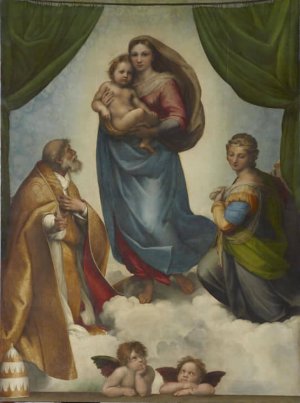
© bpk-Bildagentur
Sistine Madonna, 1512
Gemäldegalerie Alte Meister, DresdenDalí Dixit
“Just as it had been easy for me, since Señor Traite's school, to repeat the experience of seeing «anything I wished» in the moisture Stains on the vaults, and as I was able later to repeat this experience in the forms of the moving clouds of the summer storm at the Muli de la Torre, so even at the beginning of my adolescence this magic power of transforming the world beyond the limits of «visual images» burst thorough to the sentimental domains of my own life, so that I became master of that thaumaturgical faculty of being able to any moment and in any circumstance always, always to see something else, or on the other hand-what amounts to the same- «always to see the identical thing» in things that were different.”
Salvador Dalí, The Secret Life of Salvador Dalí, 1942
Educa Dalí
From early childhood, Dalí was fascinated by visual games and optical illusions. When he was at primary school, his teacher, Esteve Trayter, would show his pupils various lenses and optical devices. Young Dalí was astonished, and this experience made a huge impression on the way he saw reality, something which would remain with him for the rest of his life.
For further information
Description
- Cat. no.:
- 734
- Year:
- 1958
- Technique:
- Oil on canvas
- Dimensions:
- 225.7 x 191.1 cm
- Collection:
- The Metropolitan Museum of Art, Nova York
In 1958, Dalí wrote The Antimatter Manifesto, in which he states that his iconographic world no longer explores the internal realm of the surrealist period with constant references to Sigmund Freud (1856-1939, neurologist, father of psychoanalysis), but instead focuses on exploring the external world, the world of physics. Dalí declared that the new father of this science was Doctor Heisenberg, the physicist who developed the uncertainty principle, according to which it is impossible to know both the velocity and the position of a particle at the same time. Read more
See no. cat 734In 1958, Dalí wrote The Antimatter Manifesto, in which he states that his iconographic world no longer explores the internal realm of the surrealist period with constant references to Sigmund Freud (1856-1939, neurologist, father of psychoanalysis), but instead focuses on exploring the external world, the world of physics. Dalí declared that the new father of this science was Doctor Heisenberg, the physicist who developed the uncertainty principle, according to which it is impossible to know both the velocity and the position of a particle at the same time.
In this painting, as Dalí explains in the subtitle, he presents us with a visual game in which three different images appear depending on how far away we stand from the picture. Dalí loved visual games and optical illusions. As an example, we draw your attention to the best known of his double images, which he created several years later: Gala Nude Looking at the Sea which at 18 Metres Appears President Lincoln (1975).
Dalí Dixit
“Just as it had been easy for me, since Señor Traite's school, to repeat the experience of seeing «anything I wished» in the moisture Stains on the vaults, and as I was able later to repeat this experience in the forms of the moving clouds of the summer storm at the Muli de la Torre, so even at the beginning of my adolescence this magic power of transforming the world beyond the limits of «visual images» burst thorough to the sentimental domains of my own life, so that I became master of that thaumaturgical faculty of being able to any moment and in any circumstance always, always to see something else, or on the other hand-what amounts to the same- «always to see the identical thing» in things that were different.”
Salvador Dalí, The Secret Life of Salvador Dalí, 1942
-
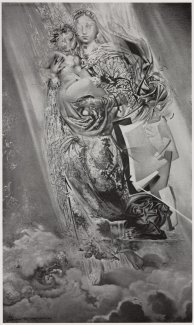
Cosmic madonna
c. 1958
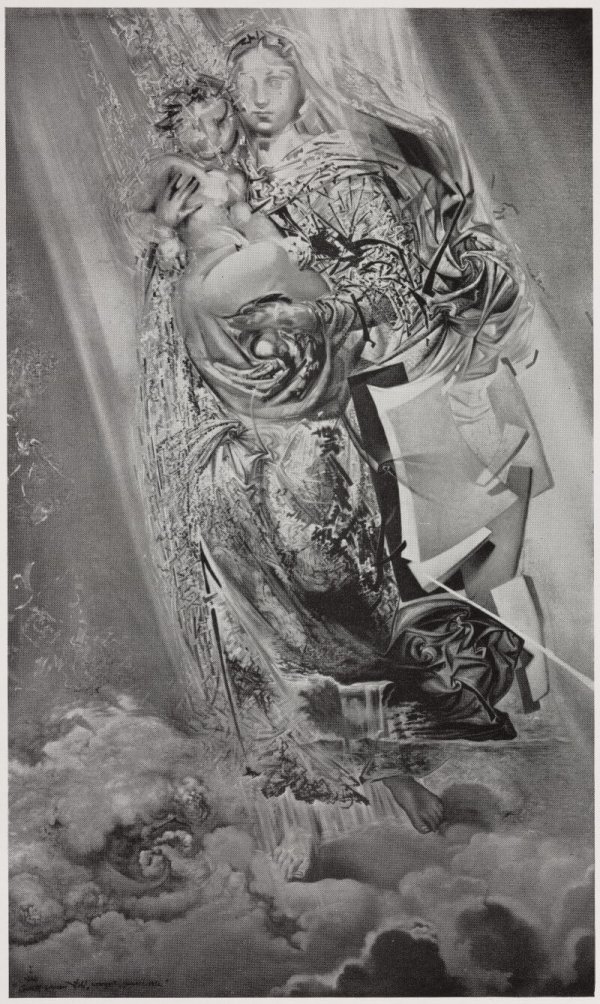
© Salvador Dalí, Fundació Gala-Salvador Dalí, Figueres, 2018 Description
- Cat. no.:
- 746
- Year:
- c. 1958
- Technique:
- Oil on canvas
- Dimensions:
- 152.4 x 91.4 cm
- Collection:
- Private Collection
Raphael's Sistine Madonna is reproduced in numerous works by Dalí, and Cosmic Madonna is another example of this. The subtitle of the painting again refers us to the theme of the ear, but this time it is Van Gogh's ear, and not an angel's. Read more
See no. cat 746At the bottom of Raphael's Sistine Madonna are the two most famous cherubs in the history of art. For Christmas 1973, Salvador Dalí created a Christmas card entitled Golden Angel which paid homage to Raphael and his cherubs. The picture was accompanied by the following text: "The raphaelesque golden angel brings the Christmas tree, august symbol of 'Gloria in Excelsis Deo'".
Reference works
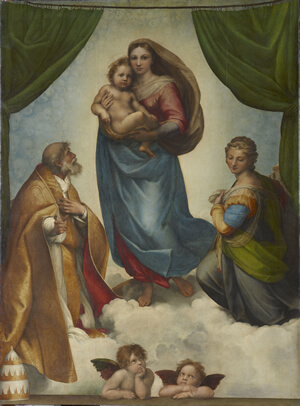
© bpk-Bildagentur
Sistine Madonna 1512
Gemäldegalerie Alte Meister, DresdenDalí Dixit
“The idea of the angel stimulates me. For if God is outside our ken, He is cosmic because without limits; but angels have shapes. Proton and neutron to me are angelic elements. Raphael and St. John of the Cross are close to the angels. I try to approach the angelic world through the hyperesthetic paranoia-critical chastity and spirituality of these illustrations. This is my discipline for getting to heaven.”
André Parinaud, Salvador Dalí, Comment on devient Dalí, 1973.
Educa Dalí
Angels appear frequently in Raphael's paintings, and also in Dalí's work. Those painted by Salvador Dalí evolve to the point of being portrayed in the shape of wash-basins, like the ones we can see in the courtyard of the Dalí Theatre-Museum in Figueres. These pieces are known as ready-mades -ordinary objects from everyday life chosen by the artist and then decontextualised and placed in a different setting, where they acquire a new poetic meaning- and are, at the same time, a nod to his friend and admired artist Marcel Duchamp (1887-1962), creator of the ready-made Fountain (1917).
For further information
Description
- Cat. no.:
- 746
- Year:
- c. 1958
- Technique:
- Oil on canvas
- Dimensions:
- 152.4 x 91.4 cm
- Collection:
- Private Collection
Raphael's Sistine Madonna is reproduced in numerous works by Dalí, and Cosmic Madonna is another example of this. The subtitle of the painting again refers us to the theme of the ear, but this time it is Van Gogh's ear, and not an angel's. Read more
See no. cat 746At the bottom of Raphael's Sistine Madonna are the two most famous cherubs in the history of art. For Christmas 1973, Salvador Dalí created a Christmas card entitled Golden Angel which paid homage to Raphael and his cherubs. The picture was accompanied by the following text: "The raphaelesque golden angel brings the Christmas tree, august symbol of 'Gloria in Excelsis Deo'".
Dalí Dixit
“The idea of the angel stimulates me. For if God is outside our ken, He is cosmic because without limits; but angels have shapes. Proton and neutron to me are angelic elements. Raphael and St. John of the Cross are close to the angels. I try to approach the angelic world through the hyperesthetic paranoia-critical chastity and spirituality of these illustrations. This is my discipline for getting to heaven.”
André Parinaud, Salvador Dalí, Comment on devient Dalí, 1973.
-
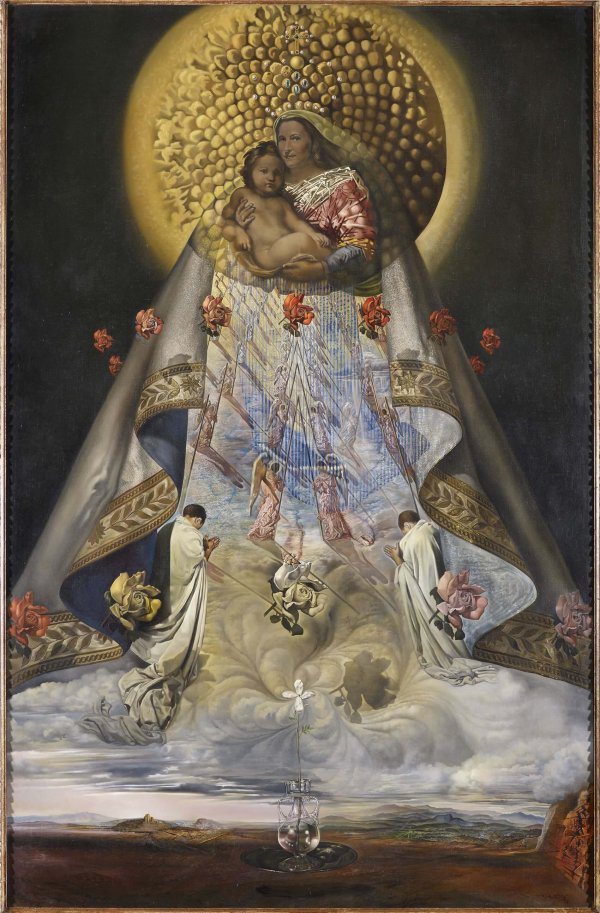
© Salvador Dalí, Fundació Gala-Salvador Dalí, Figueres, 2018 Description
- Cat. no.:
- 748
- Year:
- 1958
- Technique:
- Oil on canvas
- Dimensions:
- 200 x 130 cm
- Collection:
- Private Collection
This painting shows us how the face of the Sistine Madonna by Raphael turns into the face of Gala. Both are rocking the baby Jesus in the same way; Dalí painted The Virgin of Guadalupe with the characteristically soft, fine and harmonious shapes found in Raphael's paintings. Read more
See no. cat 748Dalí admired and constantly praised Raphael. In 1948, inspired by the Renaissance treatises he had read, he wrote his own treatise on painting, 50 Secrets of Magic Craftsmanship, in which he offers and develops advice, recommendations and ideas for young painters accompanied by illustrations. The book even includes a comparison chart in which he rates modern and classical painters on different aspects such as technique, inspiration, colour, theme, genius, composition, originality, mystery and authenticity. Obviously, Raphael, as we would expect, receives one of the highest scores.
Reference works
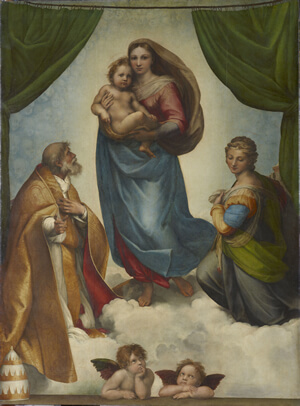
© bpk-Bildagentur
Sistine Madonna, 1512
Gemäldegalerie Alte Meister, DresdenDalí Dixit
“Raphael said that in order to make a successful picture one should think about anything else while manipulating the brush. His studios abounded with beautiful people intertwined, singers, musicians, poets who were reciting their verses. When evening comes, and you step back to look at your canvas, be surprised at what was born of your fingers. May the best of you rise above automatism, while your thoughts are sailing on a thousand variegated currents, changing, incessantly interesting, deliriously hazardous navigation from one unexpected isle to another.”
Louis Pauwels, Salvador Dalí, Les Passions selon Dalí, 1968.
Educa Dalí
In his book 50 Secrets of Magic Craftsmanship, Dalí provides a series of tips and trades for painters and artists. Look at the ten rules Dalí proposes for budding artists and try creating your own top ten tips.
Look at the ten rules Dalí proposes for budding artists and try creating your own top ten tips.
Ten rules for anyone who wishes ti be a painter
- Painter, it is better to be rich than poor; so learn how to make gold and precious stones come out of your brush.
- Don't be afraid of perfection: you'll never attain it!
- Begin by learning to draw and paint like the old masters. After that, you can do as you like; everyone will respect you.
- Don't throw to the dogs either your eye or your hand or your brain, for you will need them all if you are to be a painter.
- If you are one of those who believe that modern art has surpassed Vermeer and Raphael, don't read this book, just go right on in your blissful idiocy.
- Don't vomit on your picture, because it is the picture which can vomit on you after you are dead.
- No lazy masterpieces!
- Painter, paint!
- Painter don't drink alcohol, and chew hashish only five times in your life.
- If painting doesn't love you, all your love for her will be unavailing.”
Salvador Dalí, 50 secrets of magic craftsmanship, 1948.
For further information
- Lucia Moni. “Dalí,to become a classic! Now or never". November 2018
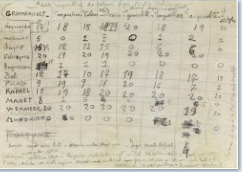
Salvador Dalí, page of the manuscript of 50 Secrets of Magic Craftsmanship with the table of comparative values, ca. 1947. Fundació Gala-Salvador Dalí, Figueres.
© Salvador Dalí, Fundació Gala-Salvador Dalí, Figueres, 2018
Description
- Cat. no.:
- 748
- Year:
- 1958
- Technique:
- Oil on canvas
- Dimensions:
- 200 x 130 cm
- Collection:
- Private Collection
This painting shows us how the face of the Sistine Madonna by Raphael turns into the face of Gala. Both are rocking the baby Jesus in the same way; Dalí painted The Virgin of Guadalupe with the characteristically soft, fine and harmonious shapes found in Raphael's paintings. Read more
See no. cat 748Dalí admired and constantly praised Raphael. In 1948, inspired by the Renaissance treatises he had read, he wrote his own treatise on painting, 50 Secrets of Magic Craftsmanship, in which he offers and develops advice, recommendations and ideas for young painters accompanied by illustrations. The book even includes a comparison chart in which he rates modern and classical painters on different aspects such as technique, inspiration, colour, theme, genius, composition, originality, mystery and authenticity. Obviously, Raphael, as we would expect, receives one of the highest scores.
Dalí Dixit
“Raphael said that in order to make a successful picture one should think about anything else while manipulating the brush. His studios abounded with beautiful people intertwined, singers, musicians, poets who were reciting their verses. When evening comes, and you step back to look at your canvas, be surprised at what was born of your fingers. May the best of you rise above automatism, while your thoughts are sailing on a thousand variegated currents, changing, incessantly interesting, deliriously hazardous navigation from one unexpected isle to another.”
Louis Pauwels, Salvador Dalí, Les Passions selon Dalí, 1968.
For further information
- Lucia Moni. “Dalí,to become a classic! Now or never". November 2018

Salvador Dalí, page of the manuscript of 50 Secrets of Magic Craftsmanship with the table of comparative values, ca. 1947. Fundació Gala-Salvador Dalí, Figueres.
© Salvador Dalí, Fundació Gala-Salvador Dalí, Figueres, 2018
-

Battle in the Clouds
c. 1979
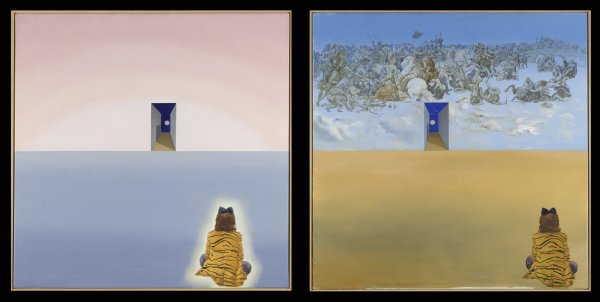
© Salvador Dalí, Fundació Gala-Salvador Dalí, Figueres, 2018 Description
- Cat. no.:
- 860
- Year:
- c. 1979
- Technique:
- Oil on Canvas
- Dimensions:
- 100 x 100 cm Left Element
100 x 100 cm Right Element - Collection:
- Museo Nacional Centro de Arte Reina Sofía, Madrid
While we find that most of Raphael's influence on Dalí's work is reflected in his Madonnas, in this case we see how he took a scene from the work Battle of Constantine against Maxentius and reproduced the bodies and movements of the characters. Read more
See no. cat 860As Dalí specifies in the title, the battle takes place in the clouds. Gala, seated with her back to us in the foreground, wearing a yellow jacket with black stripes and her customary black ribbon in her hair, seems to be contemplating the scene.
This painting is stereoscopic, creating a three-dimensional illusion. Dalí always kept up-to-date with the latest scientific and technological innovations and tried to apply them in his work. From the mid-1960s and throughout the 1970s he was particularly interested in the third dimension and sought depth in his images by using stereoscopic techniques. Dalí, once again, was ahead of his time.
Reference works
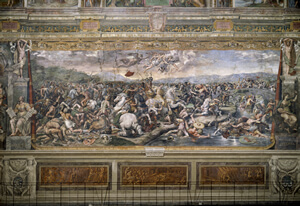
Foto Copyright © Musei Vaticani
Battle of Constantine against Maxentius 1520-1524
Musei vaticani, RomeDalí Dixit
“JM: "How has your painting method evolved?"
SD: "During the surrealist period in the 1930s, my painting was pure imaginative automatism. Now it is different: I use a photographic technique. Each picture is defined in advance by a perfectly geometrical structure. Currently I am painting stereoscopic pictures, using two mirrors that reflect each photograph. In this way, I obtain unique visions and colours. To sum up, before I painted the fantasy of reality. Today, I paint the reality of fantasy...".
Jacques Michel, Salvador Dalí, "Salvador Dalí et son musée", Le Monde, Paris, 03/10/1974
Educa Dalí
Stereoscopy is the result of viewing two almost identical images side by side. Each eye looks at one of the images, and the brain merges them, producing a sensation of depth, relief, and three dimensions.
Excited by this technique, Dalí made pairs of paintings that look identical, but are not. He slightly shifts the centre of each image in relation to the viewer's eyes and modifies the colours of both. In this way, when looking at both pictures at the same time we see a single three-dimensional image with depth.
For further information
- Montse Aguer, Carme Ruiz, exhibition: Dalí. Stereoscopic Images. Painting in Three Dimensions, Dalí Theatre-Museum, Figueres, Fundació Gala-Salvador Dalí, 2017.
Description
- Cat. no.:
- 860
- Year:
- c. 1979
- Technique:
- Oil on Canvas
- Dimensions:
- 100 x 100 cm Left Element
100 x 100 cm Right Element - Collection:
- Museo Nacional Centro de Arte Reina Sofía, Madrid
While we find that most of Raphael's influence on Dalí's work is reflected in his Madonnas, in this case we see how he took a scene from the work Battle of Constantine against Maxentius and reproduced the bodies and movements of the characters. Read more
See no. cat 860As Dalí specifies in the title, the battle takes place in the clouds. Gala, seated with her back to us in the foreground, wearing a yellow jacket with black stripes and her customary black ribbon in her hair, seems to be contemplating the scene.
This painting is stereoscopic, creating a three-dimensional illusion. Dalí always kept up-to-date with the latest scientific and technological innovations and tried to apply them in his work. From the mid-1960s and throughout the 1970s he was particularly interested in the third dimension and sought depth in his images by using stereoscopic techniques. Dalí, once again, was ahead of his time.
Dalí Dixit
“JM: "How has your painting method evolved?"
SD: "During the surrealist period in the 1930s, my painting was pure imaginative automatism. Now it is different: I use a photographic technique. Each picture is defined in advance by a perfectly geometrical structure. Currently I am painting stereoscopic pictures, using two mirrors that reflect each photograph. In this way, I obtain unique visions and colours. To sum up, before I painted the fantasy of reality. Today, I paint the reality of fantasy...".
Jacques Michel, Salvador Dalí, "Salvador Dalí et son musée", Le Monde, Paris, 03/10/1974
For further information
- Montse Aguer, Carme Ruiz, exhibition: Dalí. Stereoscopic Images. Painting in Three Dimensions, Dalí Theatre-Museum, Figueres, Fundació Gala-Salvador Dalí, 2017.
-
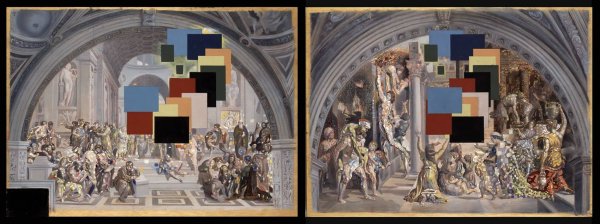
© Salvador Dalí, Fundació Gala-Salvador Dalí, Figueres, 2018 Photo © 1987 The Metropolitan Museum of Art Description
- Cat. no.:
- 896
- Year:
- c. 1979
- Technique:
- Oil on plywood panel
- Dimensions:
- 32 x 43 cm Left Element
32 x 43 cm Right Element - Collection:
- Fundació Gala-Salvador Dalí, Figueres
The School of Athens and The Fire in the Borgo are two of Raphael's most famous frescoes. The paintings are found in the Raphael Rooms of the Vatican Museums, which at the time were a suite of apartments for Pope Julius II (1503-1513). Read more
See no. cat 896The rooms had previously been decorated by other painters, such as for example Perugino, but, when commissioning Raphael, Pope Julius II gave him complete freedom and so the artist decided to start from scratch. He painted frescoes in four rooms, among them The School of Athens and The Fire in the Borgo. The first work portrays the greatest philosophers in classical antiquity and the second tells the story of how, in 847, Pope Leo IV miraculously managed to control a terrible fire by making the sign of the cross over it. Dalí placed them one beside the other to obtain a three-dimensional effect. So, we are looking at another stereoscopic work.
Reference works
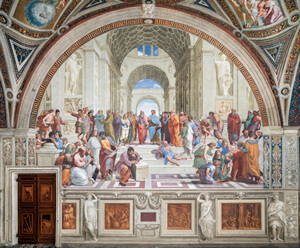
Foto Copyright © Musei Vaticani
The School of Athens c. 1509-1511
Musei Vaticani, Roma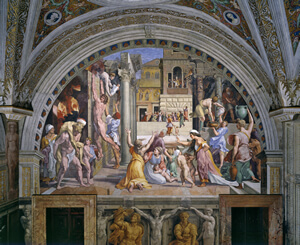
Foto Copyright © Musei Vaticani
The Fire of the Borgo 1514
Musei Vaticani, RomaDalí Dixit
"Another new interest in Dalí's life is holography, which will also be present in the Dalí Museum: it is the total third dimension, based on information and light interference, which enable visual reality to be reproduced with all its problems and wonderful possibilities. This is the work of Dennis Gabor, who won a Nobel Prize and who I have been fortunate enough to meet. I made five holograms with him, which is the most modern thing one can do, and they are the first to be created by an artist. The museum in Figueres will have the privilege of being able to exhibit, for the first time, one of these holograms. Thus, my wish is that this will be an ultra-local museum, which is what will make it possible to become universal".
Xian de Andrade, Salvador Dalí, “Dalí, sus dos caras y su museo”, Sábado Gráfico, Madrid, 17/06/1972.
Educa Dalí
Dalí's interest in recreating depth and the third dimension led him to collaborate with the holder of the Nobel Prize in Physics Dennis Gabor (1900-1979) to create the first artistic hologram in history. They would go on to produce different holographic pieces that recreated totally innovative works in three dimensions. Holography techniques are extremely complex, and with these works Dalí once again became a pioneer in his field.
For further information
Description
- Cat. no.:
- 896
- Year:
- c. 1979
- Technique:
- Oil on plywood panel
- Dimensions:
- 32 x 43 cm Left Element
32 x 43 cm Right Element - Collection:
- Fundació Gala-Salvador Dalí, Figueres
The School of Athens and The Fire in the Borgo are two of Raphael's most famous frescoes. The paintings are found in the Raphael Rooms of the Vatican Museums, which at the time were a suite of apartments for Pope Julius II (1503-1513). Read more
See no. cat 896The rooms had previously been decorated by other painters, such as for example Perugino, but, when commissioning Raphael, Pope Julius II gave him complete freedom and so the artist decided to start from scratch. He painted frescoes in four rooms, among them The School of Athens and The Fire in the Borgo. The first work portrays the greatest philosophers in classical antiquity and the second tells the story of how, in 847, Pope Leo IV miraculously managed to control a terrible fire by making the sign of the cross over it. Dalí placed them one beside the other to obtain a three-dimensional effect. So, we are looking at another stereoscopic work.
Dalí Dixit
"Another new interest in Dalí's life is holography, which will also be present in the Dalí Museum: it is the total third dimension, based on information and light interference, which enable visual reality to be reproduced with all its problems and wonderful possibilities. This is the work of Dennis Gabor, who won a Nobel Prize and who I have been fortunate enough to meet. I made five holograms with him, which is the most modern thing one can do, and they are the first to be created by an artist. The museum in Figueres will have the privilege of being able to exhibit, for the first time, one of these holograms. Thus, my wish is that this will be an ultra-local museum, which is what will make it possible to become universal".
Xian de Andrade, Salvador Dalí, “Dalí, sus dos caras y su museo”, Sábado Gráfico, Madrid, 17/06/1972.
-
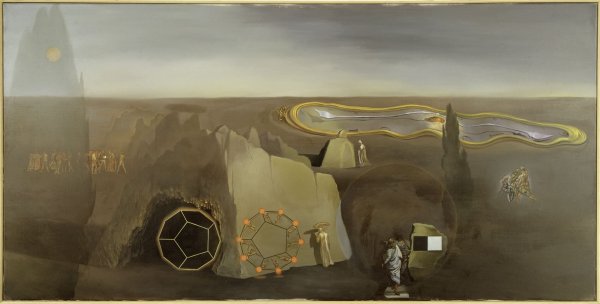
© Salvador Dalí, Fundació Gala-Salvador Dalí, Figueres, 2018 Description
- Cat. no.:
- 908
- Year:
- c. 1979
- Technique:
- Oil on Canvas
- Dimensions:
- 122.5 x 246 cm
- Collection:
- Fundació Gala-Salvador Dalí, Figueres
In this enigmatic painting we find different dalinian elements from the past and present, merged together with various artistic references within the space-time continuum. Read more
See no. cat 908On the left there are a series of characters taken from Delivery of the Keys to Saint Peter by Perugino, between a cypress and the rocks from Isle of the Dead by Arnold Böcklin (1827-1901, Swiss symbolist painter). On the right we find a battle scene with some immobilised prisoners, which Dalí copied from a drawing by Raphael. This is not the only reference he makes to the Renaissance artist: in the foreground, facing away from us, there are also a couple of characters from the previously mentioned painting The School of Athens. Together with all these elements we can also see a soft clock that looks like a fried egg and a pentagonal sardana alluding to the golden pentagon. All these references fit together with the physics subject; in this case, the mysterious search for the fourth dimension.
Reference works
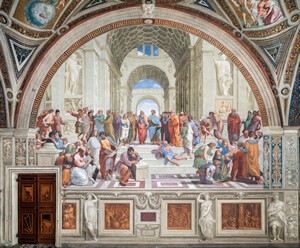
Foto Copyright © Musei Vaticani
The School of Athens c. 1509-1511
Musei Vaticani, RomeEduca Dalí
The title of this piece In Search of the Fourth Dimension reveals Dalí's great interest in exploring a new dimension that incorporated the space-time continuum, a subject we see reflected in several of his works.
Above all, we can see it developed in the figure of the hypercube, which would be the geometrical representation of a cube in the fourth dimension. A space in four dimensions or 4D is a mathematical extension of the concept of three-dimensional space or 3D. A three-dimensional space is the simplest generalisation possible of observation, in which only three numbers -or dimensions- are required to describe the measurements or locations of objects in our daily world. For example, the volume of a cube can be calculated by measuring its length, width and depth.
In turn, space in four dimensions incorporates the same variables we find in three-dimensional space and, in addition, the space-time continuum. This may all sound rather complicated, but it is normal! The 4D concept is totally alien to us because we are used to representing our world in the three physical dimensions.
For further information
- Elliot H. King. Liquid Desires. NGV: Melbourne
Description
- Cat. no.:
- 908
- Year:
- c. 1979
- Technique:
- Oil on Canvas
- Dimensions:
- 122.5 x 246 cm
- Collection:
- Fundació Gala-Salvador Dalí, Figueres
In this enigmatic painting we find different dalinian elements from the past and present, merged together with various artistic references within the space-time continuum. Read more
See no. cat 908On the left there are a series of characters taken from Delivery of the Keys to Saint Peter by Perugino, between a cypress and the rocks from Isle of the Dead by Arnold Böcklin (1827-1901, Swiss symbolist painter). On the right we find a battle scene with some immobilised prisoners, which Dalí copied from a drawing by Raphael. This is not the only reference he makes to the Renaissance artist: in the foreground, facing away from us, there are also a couple of characters from the previously mentioned painting The School of Athens. Together with all these elements we can also see a soft clock that looks like a fried egg and a pentagonal sardana alluding to the golden pentagon. All these references fit together with the physics subject; in this case, the mysterious search for the fourth dimension.
For further information
- Elliot H. King. Liquid Desires. NGV: Melbourne



